Matador Network's Blog, page 461
June 17, 2022
This Eco-Ranch in Mexico Has 34,000 Acres of Adventure, From Mountain Biking To Cheesemaking
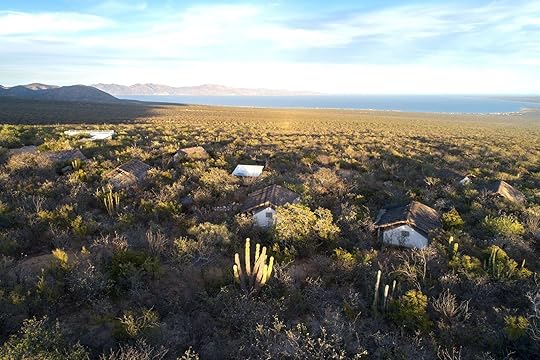
I’m surrounded by the Sierra Cacachilas in Baja California Sur, Mexico, eating a trio of cheeses with wild cape plums prepared two ways: pickled and preserved. To my left is a pen filled with goats who produced the milk to make the cheese. Straight ahead, the branches of a tamarind tree bow toward the gate to an organic garden. The pods that hang from its long limbs were used to flavor the tart, earthy water I’m sipping. To my right, in the distance, I can retrace the tracks I’ve just left on a desert trail where I learned to identify the wild cape plum tree, the healing lomboy tree, and the giant cardon cactuses that have been standing sentinel over these lands for centuries.
This is an afternoon at Rancho Cacachilas, a 34,000-acre eco-ranch about two hours north of Cabo San Lucas, whose namesake shrub I also encountered on that morning’s hike.

Photo: Alex Bresler
Technically, Rancho Cacachilas is a network of ranches. Cheese tastings are held at Rancho Dos Hermanos, whose creamery produces seven goat cheeses including a traditional panela that guests can learn to make during an artisanal cheese workshop. For most overnighters, Rancho Chivato is home base — with eight safari-style glamping tents, four rustic resort suits, communal spaces for mealtime and downtime, and a pool that points toward the Sea of Cortez — although guests can also sleep wild at the Los Pisos wilderness camp.
The majority of the food that’s served in Rancho Chivato’s al fresco dining room is grown down the road at Rancho Gaspareño, the eco-ranch’s reception area, which also stables its mules and horses and hosts monthly ranch-to-table culinary events.

Photo: Alex Bresler
Between ranches, 40 miles of hiking and mountain biking trails crisscross the property, and there are more trails underway. Mountain bikers, in particular, have come to regard Rancho Cacachilas’ singletrack as some of Mexico’s finest, anchored by the six-mile Santa Rosa Trail that was designed by the International Mountain Biking Association.
On Saturdays throughout the year, this same singletrack opens up to trail runners who meet at the eco-ranch’s Bike Hub in the nearby windsurfing town of El Sargento before being shuttled to various trailheads. The most formidable race in the series is the Don Diablo Trail Run, which is split into 35K and Ultra 54K marathons every November.
The whole solar-powered plot is owned by Christy Walton — of the Walmart Waltons — who established Rancho Cacachilas to restore the area’s ecological and cultural heritages.
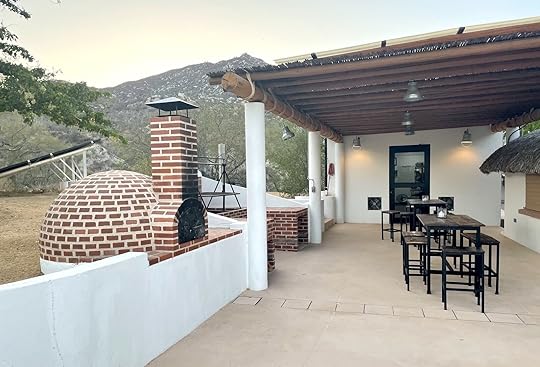
Photo: Alex Bresler
“There’s no money in ranching,” says Sebastián Del Valle, my guide during my two-night stay at the eco-ranch. Del Valle explains that most of the locals who can afford to send their kids to Mexico City or abroad when they’re older do so to provide them with better opportunities. “Here, ranchers get paid 300 percent more … so we’re helping the community rebuild their ranches, go back to their roots.”
Guest workshops from beekeeping and cheesemaking to permaculture and livestock management are also available to locals, who represent 80 percent of the eco-ranch’s workforce. In the case of foreman Joaquin Geraldo, the property’s longest-standing employee, Rancho Cacachilas has become a multi-generational family employer. His sons now works as a bike mechanic at the Bike Hub and fills in as a guide when needed.
Tourism was a secondary objective for Walton. Rancho Cacachilas began taking shape 14 years ago but only opened to guests five years ago. Before that, the property primarily operated as a base for researchers from the San Diego Natural History Museum who continue to study the region’s wildlife and natural resources today. Yet tourism to the Sierra Cacachilas seemed inevitable as interest in La Paz, the state capital about 40 minutes southwest, ballooned.
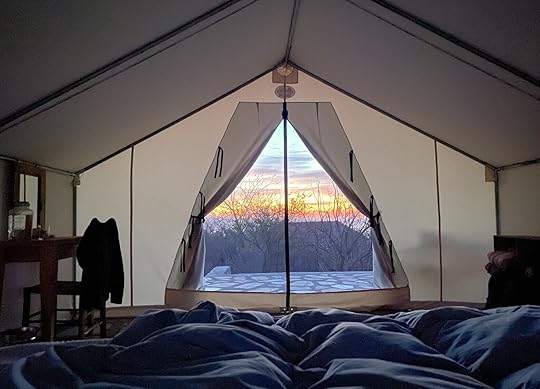
Photo: Alex Bresler
“That’s how tourism started here,” says Del Valle. “It was just grabbing tourism by the hand and growing together, not just in a sustainable but a regenerative way.”
Hearing Del Valle explain that sustainability is no longer a sufficient model for tourism, that the goal of the eco-ranch is to actively regenerate the land it occupies, it’s hard to picture a better spokesperson for Rancho Cacachilas — both equally rugged yet refined. But Del Valle had reservations before accepting his position as a guide.
“I didn’t want to work here if all of the money would go to Walmart,” he tells me over a plate of mixed vegetables from the eco-ranch’s garden, roasted chicken thighs, and mole during my last lunch at Rancho Chivato. “But actually it’s the other way around.”

Photo: Alex Bresler
Rancho Cacachilas is just one leg of iAlumbra, a Walton-founded alliance of Mexican businesses that’s committed to creating “environmental, social, and economic improvements” that are both serviceable and enduring in communities across the country. In addition to the watershed restoration, holistic ranching, permaculture, and community outreach taking place on site, Rancho Cacachilas also partners with two of iAlumbra’s aquaculture ventures—Sol Azul, one of Mexico’s leading oyster farms, and Earth Organic Farms, the first hatchery in the world to breed Pacific red snapper—to supplement the meals served to guests.
The eco-ranch has yet to turn a profit, in part because the COVID-19 pandemic curtailed its momentum as a touristic undertaking. But according to Del Valle, that’s okay.
“This ranch is not for money,” he says. “It’s for the ranchers.”

Photo: Alex Bresler
The irony is that Rancho Cacachilas is an experience adventurers would be remiss to skip. It only takes one night of stargazing by the firepit at Rancho Chivato, or a morning of sunrise yoga on the rooftop of the resort rooms, to see that — as long as you’re the type of traveler who’s comfortable taking warm bucket showers before cocktail hour.
At roughly $300 per night, glamping at Rancho Cacachilas is not the cheapest way to bum around Baja California Sur. But you’d be hard-pressed to find a more exciting, educational, beautiful, and beneficial property to give your hard-earned vacation dollars to. 
A First Look Inside Ellen DeGeneres’s New Gorilla Conservation Center in Rwanda
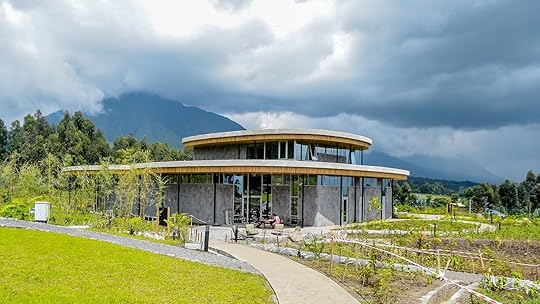
When Ellen DeGeneres was a kid, the only magazine she had in her house was National Geographic.
“I was reading it and saw this woman working with gorillas in Africa,” the comedian and talk show host said. “And I had never been out of New Orleans, so when I was a kid it was my dream coming (to Africa), Dian Fossey was my hero.”
Ellen never did become a gorilla researcher like Dian Fossey. But fast forward to 2018, and Ellen’s wife Portia de Rossi gave her a gift that got her close. During an episode of The Ellen DeGeneres Show, de Rossi announced the Ellen Fund would be building a new campus for the Dian Fossey Gorilla Fund in Rwanda, creating a research and education center to continue Fossey’s work for generations.
Four years later, the center opened at the base of Volcanoes National Park this spring. The 45,000-square-foot campus is an awe-inspiring new nature center, and is a must-visit jumping off point for anyone planning a gorilla trek.
A stunning research center for the world
Photo: Chris Schwagga
The new Ellen Degeneres Campus of the Dian Fossey Gorilla Fund sits on an old potato farm just outside Volcanoes National Park in northwest Rwanda. The sprawling space spans a dozen acres, with three buildings connected by meandering pathways lined with jungle vegetation. The intent, according to MASS Design CEO Michael Murphy, is to give guests the feeling of being a gorilla wandering through the mountains.
The buildings are equal parts education and research, beginning with a conservation center for visitors, then expanding back into working labs for Fossey Fund scientists. The labs provide much-needed, state-of-the-art space for researchers to continue their conservation efforts.
“We were working out of a rented facility 25 miles away, with one classroom for 400 university students,” Fossey Fund CEO Dr. Tara Stoinski said on a recent trip I took to the center. “We had one lab, it was a previous kitchen, you could fit about two people in it – one trainer and one student. Now we have six labs, and they’re absolutely gorgeous.”
In addition to giving researchers more room, the labs also allow scientists to perform analysis that previously had to be outsourced to the United States. Now, local teams can examine things like stress hormones in the gorillas’ stools to learn what might be stressing them out.
“This campus really serves as a training ground, not just for Rwanda, but for the region and internationally,” Stoinski added. “We can bring career scientists together to think about what solutions we may need for climate change.”

Photo: Elsemieke de Boer, MASS Media
The campus also includes the Rob and Melani Watson Education Center, where school groups and other students can learn all about the Fossey Fund and the importance of gorilla conservation. Since the center soft opened in February, it’s already hosted over 2,000 students and teachers from nearby primary and secondary schools.
Immerse yourself in the world of Dian Fossey and her gorilla friends
Photo: Chris Schwagga
The star of the show, however, is the Cindy Broder Conservation Gallery, which is effectively the museum and visitors center. It’s a stunning, user-friendly walk-through interactive space that tells the story of both Dian Fossey and the gorillas she loved.
The gallery begins with a welcome video from Ellen Degeneres explaining the importance of Dian Fossey and gorilla conservation. It then moves into a timeline of Fossey’s life, through her work with gorillas and her untimely death in 1985. Along the way, guests step into a mocked-up version of her cabin in the jungle, complete with Fossey artifacts like her original desk, research maps, and letters to family that became the basis for Gorillas in the Mist.
From there, guests walk through the Gorilla Hall of Fame, where they read the stories of famous apes like Digit, Maggie, and Titus. The hall offers an interactive “Which Gorilla Are You?” quiz, a little like Buzzfeed with a conservation bent.

Photo: Chris Schwagga
Guests can also learn how to speak like a gorilla (do your best Cookie Monster imitation and you’ve got a good start) and see a real silverback skeleton standing next to a human one. The center also offers a section on gorilla conservation and what visitors can do to help. There’s also a 360-degree movie theater courtesy of Leonardo DiCaprio, where a juvenile gorilla from one of the local gorilla families leads guests through an immersive day in the life of a primate.
It ends in a gift shop that has far more than typical museum kitsch. The Azizi Life store features gifts crafted by local artisans, where each purchase goes directly to support Rwandan communities. Everything from hand carved kitchen utensils to masks and peace baskets are on display, all reasonably priced with tags explaining the people who made them.
Green space that helps the community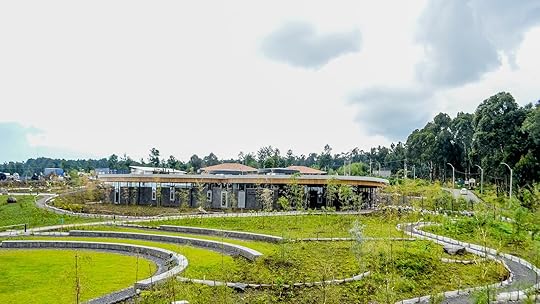
Photo: MASS Design Group
The campus’ landscape and design is almost as impressive and important as the work going on inside. The three-year construction project employed 2,400 local workers, nearly a quarter of whom were women.
The stones that bolster the center’s walls and pathways are all volcanic rock from the surrounding landscape, hand cut by masons during the construction process. Each building is also topped with a Green Roof, where native plants attract birds, bees, and other species with additional elevated vegetation.
“It was incredibly important that we try to be intentional about every design decision, having a maximum impact on the people and the places in which it serves,” Murphy said. “It’s our responsibility to make something that has meaning and endures.”
Beyond its aesthetics, the new Ellen Campus gives aspiring gorilla trekkers a natural jumping off point, and a place to educate themselves on the animals and environment they’re about to explore. It serves the dual purpose of providing an educational resource for visitors, and a space for scientists to further their research, accomplishing a dream Dian Fossey would no doubt admire.
“There are so many stories that will come out of this one place, the one idea,” de Rossi said. “And I think that’s what I’m most proud of.” 
Airbnb Now Has a Towers Category. These 9 Will Climb Your Bucket List

Visitors can scope out the sights from the highest rooms in the tallest(ish) towers at these nine destinations across the world that we already wish we were booked at this summer. From Joshua Tree’s Castle Guard House Estate escape to a Majestic Treehouse in Brazil or a romantic sky-high escape nestled into some gorgeous gardens in Australia, here are some of the coolest, cloud-level castle-type Airbnb towers in the world.
We hope you love the Airbnb towers we recommend! Just so you know, Matador may collect a small commission from the links on this page if you decide to book a stay. Listed prices are accurate as of the time of publication.
This Castle House Estate Guard Tower Suite with Pool, Joshua Tree, California, U.S.
Photo: Airbnb
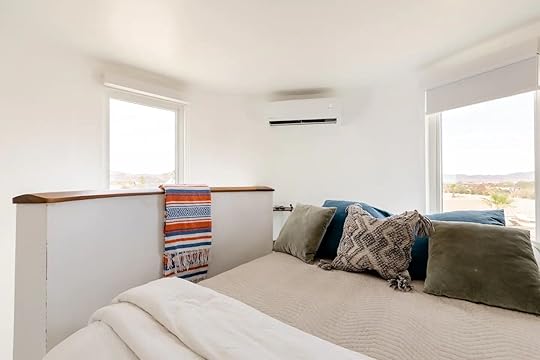
Photo: Airbnb
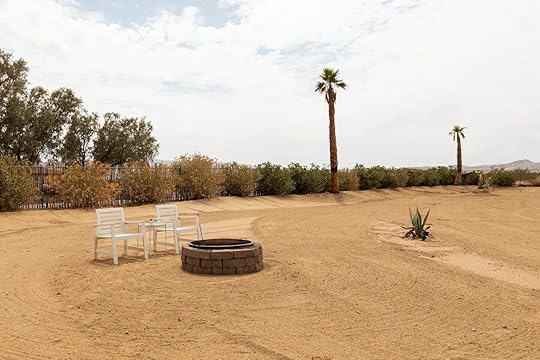
Photo: Airbnb

Photo: Airbnb
This Castle House Guard Tower in the heart of Joshua Tree is the ultimate “glamping” experience, and it’s just minutes from the National Park. This three-story tower with a loft space is comfortably made to sleep two guests, with one bedroom and one bathroom and 120 square feet per floor. The architecture of the structure seemingly blends indoor-outdoor living and is set on eight gorgeous acres of practically open space. Even the furniture in this building was specifically made to fit into the unique round design — and additional indoor amenities include a mini-refrigerator and Nespresso coffee maker. Outdoors, guests can enjoy a wood-burning fire-pit, a grill top, and two chairs — a perfect spot for getting cozy under the stars. There’s a separate restroom facility just 20 steps away with two private toilets, and two outdoor showers for the unique opportunity to bathe “al fresco.”
Two guests, one bedroom
Price: $322 per night

Photo: Airbnb

Photo: Airbnb
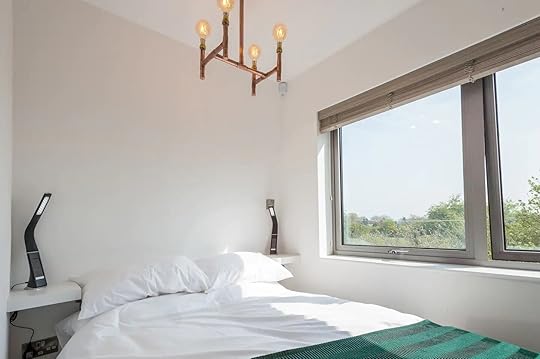
Photo: Airbnb
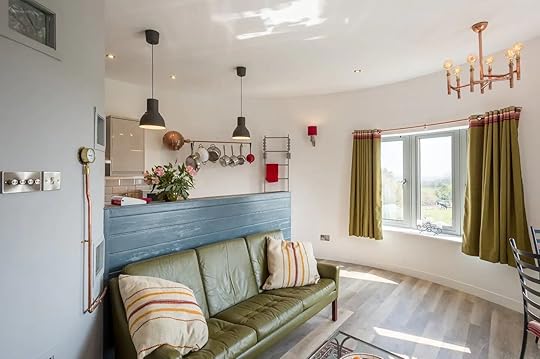
Photo: Airbnb
Sleeping four guests in two bedrooms with ensuite bathrooms, the Water Tower at Long Meadow Farm is perfectly perched on the edge of an orchard with spectacular surrounding views of the Warwickshire countryside, below. The original components of the historic tower have been mostly preserved, but the construction company that worked on renovating the space actually won a Federation of Master Builders regional award for their impressive work, on this site and the decor inside is clean, modern, and chic. The tower is flanked on every angle by quaint, rural sights like horses grazing in a nearby field, or the resident ducks roaming the grounds. Guests can enjoy a private outdoor patio, and the comforts of home (with electricity supply partially gathered from Solar panels, outside!) including a fridge and freezer, a microwave, a Nespresso coffee machine, and even a Smart TV —as well as honey from the on-site bees for morning coffee or tea.
Four guests, two bedrooms
Price: $211 per night
Planning an epic trip? Check out Matador’s accommodation guides to the best places to stay:10 epic treehouses you can actually rent on AirbnbThese Airbnbs make you feel like you’re living in Game of ThronesStay like royalty at these Airbnb Ireland castle rentalsThis Holiday Tower in Bad Kissingen, Bayern, Germany
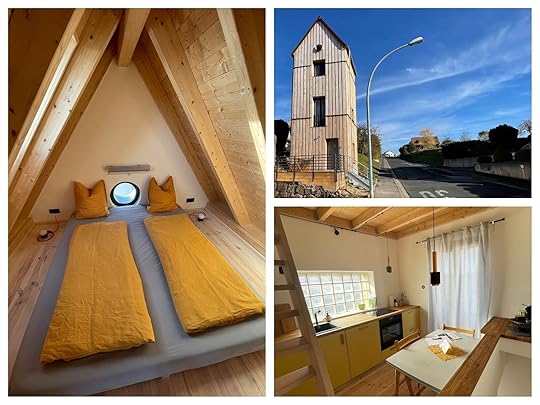
Photo: Airbnb
Two guests can comfortably enjoy the one bedroom, one bathroom space in this tower “to the former Poppenroth substation,” which can be reached via an external staircase leading to nearly 400 square feet of living area. The inside is furnished with warm wood tones, clean shades of white, and cream finished off with furnishings of steel. There’s a dedicated workspace for those who seek a spot to cultivate personal inspiration. Outside, there’s a deck outfitted with furniture that’s perfect for watching the sunset — and inside, the living room is fully equipped with a smart TV for cozying up and watching a movie. The kitchen is also fully equipped with a fridge, a coffee maker, a toaster, a kettle, and an induction oven/stove as well as a sink and a dishwasher. It’s a fantastic getaway with mountain views and peaceful vibes.
Two guests, one bedroom
Price: $89 per night

Photo: Airbnb

Photo: Airbnb
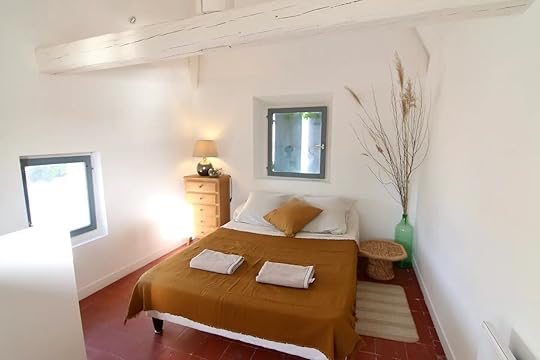
Photo: Airbnb
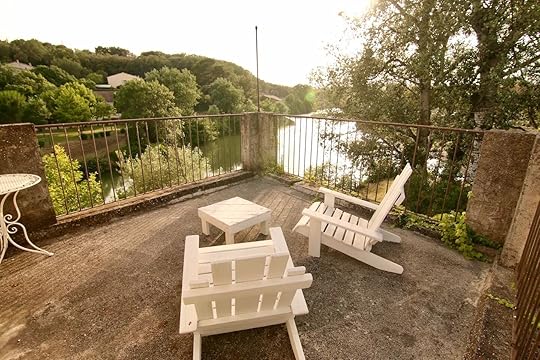
Photo: Airbnb
On the Bédarrides peninsula, just 15 minutes from Avignon, France, travelers can stay at this romantic, waterfront, ivy-covered tower nicknamed “Le Pigeonnier,” which translates to “Dovecote” or “house of the doves” — complete with a fully equipped kitchen, two bedrooms, a large bathroom, a living room. Inside, the kitchen and living space decor features tones of cool blue and gray, matching the blue of the vast sky outside as seen from the terrace outside, which offers sweeping river and park views. The bedrooms are outfitted with upbeat tones of rust, bright yellow, and red tile, making for a cheerful spot to retire for the evening while relaxing to the soothing sounds of the river down below.
Three guests, two bedrooms
Price: $107 per night
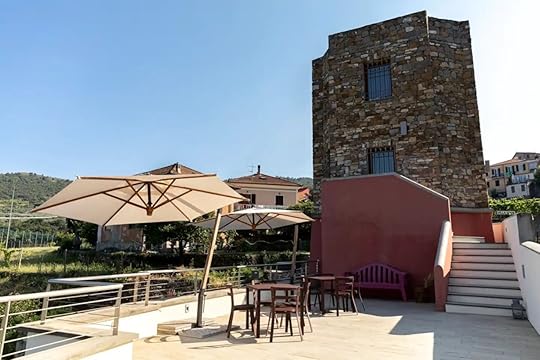
Photo: Airbnb
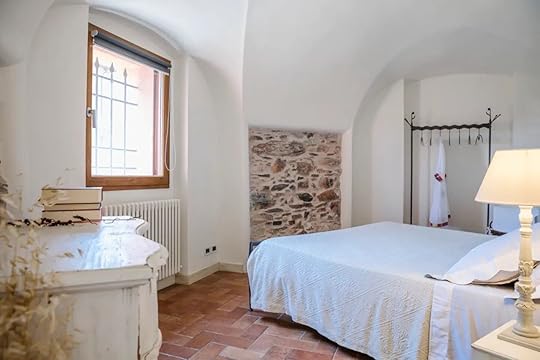
Photo: Airbnb
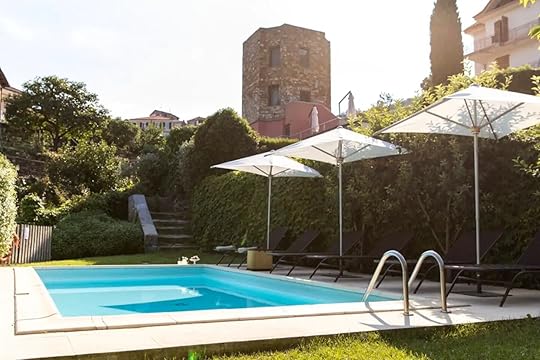
Photo: Airbnb

Photo: Airbnb
Sleeping eight guests in three bedrooms, this historic stone tower nicknamed “Torre Rossa” or “Red Tower,” in Italian, dates all the way back to the 1500s when it was first used as a watchtower. It has since been lovingly restored to offer three accommodation spaces that host guests in a classic setting, polished with all the contemporary comforts of modern life but still preserving the authenticity of its original structure. Inside, the decor is a beautiful mix of clean whites and warm tones of tan, with stone flooring in the bright, sunlit kitchen. Outside, travelers can spend time in the quaint backyard or on the enormous patio soaking up the Italian sunshine. There is even a swimming pool for the exclusive use of on-site guests to cool off on a hot day.
Eight guests, three bedrooms
Price: $136 per night

Photo: Airbnb

Photo: Airbnb

Photo: Airbnb
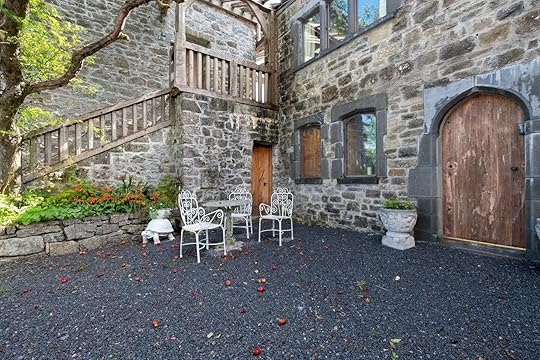
Photo: Airbnb
The Claregalway Castle in Galway, Ireland is a fully restored 15th-century Anglo-Norman tower house that offers accommodations in a few rooms — one of which is the “River Room,” situated beside the Castle on the banks of the River Clare. The room features under-floor heating and luxurious bedding, for a relaxing evening’s stay, and also includes complimentary wine, tea and coffee, and tasty continental breakfast in the morning. It’s in a fantastic location just 6 miles from Galway City Center and within walking distance of a bus stop, restaurants, bars, and the Abbey. The best part of the spot might just be the outdoor terrace area which is directly adjacent to the Castle tower — guests will have access to the tower and the charming castle grounds throughout the duration of their stay.
Two guests, one bedroom
Price: $209 per night
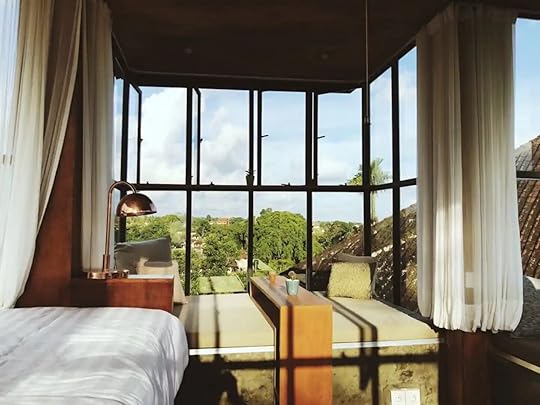
Photo: Airbnb

Photo: Airbnb
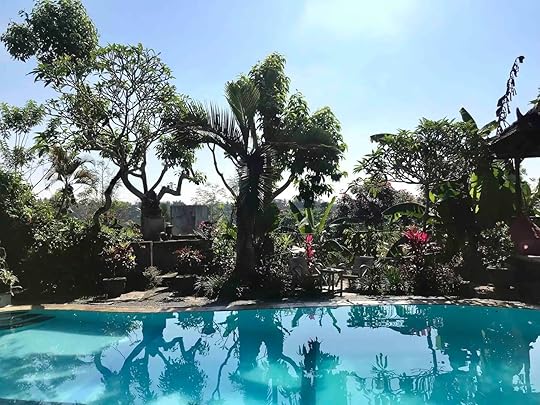
Photo: Airbnb

Photo: Airbnb
Visitors of this water tower in Ubud, Bali, Indonesia will wake up in this modern treehouse watching the sunrise behind Mount Agung and soaking in the extraordinary views over Penestanan, Ubud. The panoramic windows at the top of this modern tower nestled into the treetops are the perfect spot to enjoy seclusion and space nestled into the lush surroundings of the jungle. Two guests can comfortably enjoy this one bedroom, one bathroom accommodations across these two stories, to relax and rejuvenate. There’s a garden outside, and a nice area for barbecuing – as well as a lovely shared pool for taking a dip when temperatures heat up. For those who want to cook or make a cup of coffee, there’s another house on the grounds with a large kitchen for access to these added amenities.
Two guests, one bedroom
Price: $68 per night
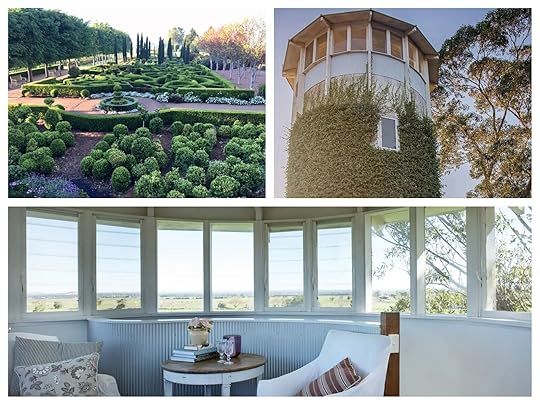
Photo: Airbnb
The Silo at Merribee is set on seven expansive acres of pristine gardens that change with the seasons (but don’t worry, there’s always something beautiful in bloom). The space serves as a unique, private one-bedroom apartment in a converted grain silo. The first flight of stairs takes guests to the bathroom level, which features a freestanding claw-footed bathtub with a gorgeous view of the greenery, outside. The second flight of stairs takes visitors up to the main bedroom, with a cozy double bed and panoramic views on three sides of the gardens, below. The third (and final) flight of stairs leads to the lookout and lounge area where travelers can relax and enjoy the sights from out the windows that encircle the entirety of the top floor.
Two guests, one bedroom
Price: $218 per night

Photo: Airbnb
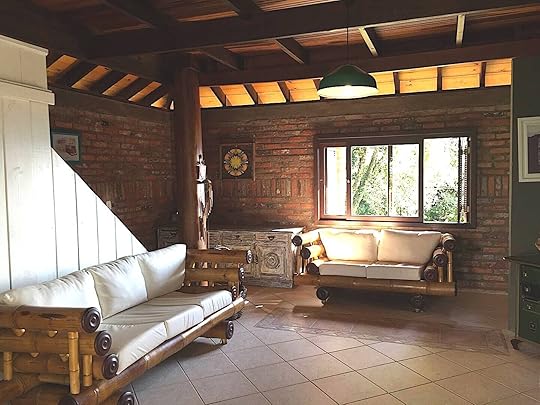
Photo: Airbnb
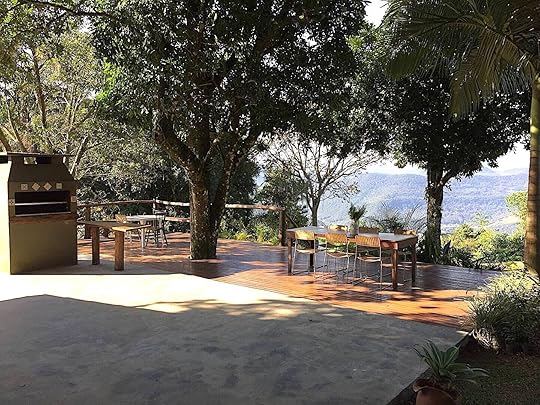
Photo: Airbnb
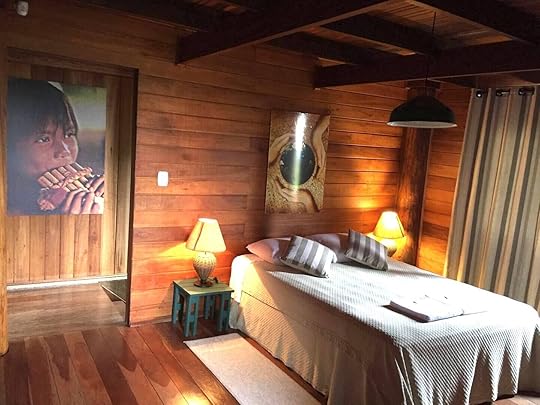
Photo: Airbnb
This Brazilian tower perch can accommodate six (adventure-loving) guests in three in a house built among the trees, featuring panoramic views of the scenery below. This treehouse is surrounded by mountains — and guests can enjoy spying on the variety of diverse bird and animal species that call the region home. The interior of the tower seemingly perfectly blends into the exterior — meaning the rich greens and deep, dark wood tones offer a sense of the natural outdoor environment even within this space. The tower feels like a secluded haven in the heavens, ideal for those who want to immerse themselves in the landscape and feel as if they’re living amongst the skies. 
Six guests, three bedrooms
Price: $133 per night
To See the Best of Elvis’s Birthplace, Go Beyond Tupelo’s Little Wooden House
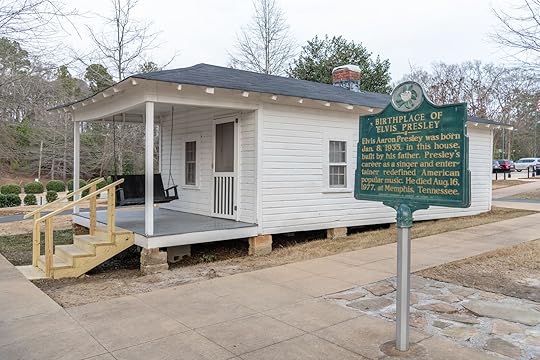
The hard wooden booth at Johnnie’s Drive-in hardly seems like a throne fit for a king. It’s square and upright in the way furniture designed before the 1950s is, like an old school desk that makes you feel sorry for school kids of yesteryear.
But the booth was good enough for a young Elvis Presley, native of Tupelo, Mississippi, and a regular at Johnnie’s, the city’s oldest restaurant. Look above the booth, and you’ll see a picture of the King, smiling over his hamburger in this exact spot. Johnnie’s is but one of the many Elvis-infused attractions in Tupelo, a city oft visited for the King’s birthplace and left just as fast. But delve past the shotgun shack on Elvis Presley Boulevard. and you’ll find a place worth sticking around a while, where music history, food, and the King of Rock and Roll converge.
Start in the birthplace of The King
Photo: Bennekom/Shutterstock
No city in America is as devoted to one person as Tupelo is to Elvis Presley. While it stops short of being a theme town, his presence is everywhere. From murals covering downtown streets to plaques marking places The King swam and watched movies, Tupelo is an Elvis fan’s dream. It’s an immersion in all things Elvis, where a stroll through downtown teaches you about his famous homecoming performance at the Mississippi-Alabama Fair and Dairy Show, and a stop by a local theater teaches you how Elvis got his Hollywood inspirations.
The Elvis Presley Birthplace and Museum is certainly the city’s main event, like the Eiffel Tower in Paris or the Empire State Building in New York. The tiny house where the King came into the world has expanded to an entire campus complete with a biographical museum and a stunning hilltop overlook. It’s a brilliant contrast when coming from Graceland, seeing how Elvis started in such a humble space.
From the birthplace, Tupelo has a guided Elvis trail, best done by bicycle when the weather is cooperating and by car when it’s not. The 13-stop tour takes you past the elementary and middle schools Elvis attended, his old favorite swimming hole, and the Tupelo Hardware store where his mother bought him his first guitar. Stop in, and the store staff will just as easily tell you about how Elvis bought his guitar as they will sell you a drill bit.
Where to eat and drink in TupeloView this post on InstagramA post shared by Kermits Soul Kitchen (@kermitsoulkitchen)
All the Elvis stuff can be done in about half a day. But once you’ve gotten your Elvis fix, exploring the rest of the city gives you a far stronger sense of the place the King was born. Downtown is blissfully walkable, and from Tupelo Hardware you’re less than five minutes on foot from fantastic food, eye-popping desserts, and bars full of welcoming locals.
Everywhere you go in Tupelo, someone will be happy to talk your ear off about all there is to see. Your first stop should be The Stables, a cheerful dive with $2 beers set in an old livery. Inside, a cast of characters who’ve all known each other for years trade friendly barbs as they yell over each other to offer recommendations. Don’t be surprised if the owners come out with a plate of their trademark blackened catfish nachos, just because they want to show off for an out-of-towner.
Odds are someone will also send you in the direction of Kermit’s Outlaw Kitchen. This funky, fast-casual spot slings fruit-forward frozen margaritas, best enjoyed while people-watching on the sidewalk. The menu is a mix of southern smoked specialties and modern global stuff, so you can pair pork belly burnt ends or pulled smoked chicken with a poke bowl and edamame.
Further down Main Street, pop into the Amsterdam Deli, a middle eastern-inspired bar and restaurant that’s also home to Tupelo’s best pizza. The intricate ceiling and brick walls make it feel like an historic bar in a big city. And the gyro nachos and Masakhan chicken wraps show that Tupelo’s cuisine extends far past bar food.
Around the corner and across from the towering historic courthouse you’ll find Crave, where calories-don’t-count desserts complement an impressive lineup of single-origin coffees. Opt for the cast iron skillet chocolate chip cookie, topped with ice cream and chocolate sauce.
While the city doesn’t have any breweries, it is home to the state’s only meadery at Queens Reward. This spot is set under towering pine trees and offers wine-style meads made from local Tupelo honey that are perfect for sipping on a hot summer day. Also be sure to try one of the mead slushies, which are mead-spiked fruity frozen drinks that make northern Mississippi feel momentarily like Mexico.
View this post on InstagramA post shared by Blue Canoe (@bluewaterwagon)
For live music, meander out of downtown a bit to Blue Canoe. Local acts play here almost nightly, but the food is just as much a draw. The place is typically packed, as people enjoy stuff like Memphis rubbed edamame, duck quesadillas, and pot roast with cornbread waffles as guitarists strum in the background. It’s also got Tupelo’s best beer selection, and a crowd of locals who’ll happily share more places to explore.
Cap off the night at Spring Street Cigars, a New Orleans-style cigar lounge across an alley from Stables. The two-story lounge boasts a walk-in humidor, full bar, and expansive balcony, where you can relax with a smoke and a bourbon in the warm night air.
Where to stay in TupeloView this post on InstagramA post shared by Hotel Tupelo (@hoteltupelo)
Tupelo’s greatest new addition is the gleaming new Hotel Tupelo, a Wyndham-flagged boutique that looks like it’s been standing for decades. In truth, it only opened within the last year, boasting floor-to-ceiling windows that integrate the indoor space perfectly with Main Street outside.
It’s home to Jobos Surf & Turf, a Caribbean and Gulf seafood spot that’s equal parts upscale eatery and city social center. The sunny patio is a go-to for happy hour, and when the summer swelter is too much the action moves inside to Tupelo’s only shuffleboard table. Stay for dinner, and you’ll find the best seafood in the city, where the crazy octopus with bacon lardons stands out for starters, and the Santa Cruz steak and ginger scallion noodles with pork belly will finish you off into a food coma.
Indigenous history right outside of Tupelo
Photo: traveler jordan/Shutterstock
Before leaving town, you can burn off some food and learn a little bit of history along the Natchez Trace. The US National Parkway cuts just west of downtown, and within three miles of the crossing you’ll reach a Chickasaw Village site. Here you can walk around an old native encampment, then stroll through the woods and learn about how Indigenous people used local plants.
A mile or so further sits the Natchez Trace visitors’ center, with a museum telling the story of the trace and its role in American history. While it quizzically glances over the trace’s use during the domestic slave trade, it does explain its importance as a route from Appalachia to the Mississippi River, and the role it played in early Southern development. It also has miles of hiking trails to explore the woods intrepid traders once roamed.
Tupelo is far more than an educational day trip for Elvis die-hards making the pilgrimage to Graceland. It may have an inescapable Elvis aura, but with food, drinks, and a sprinkling of history, it’s a fun place to immerse yourself in the world where the King began. Whether you’re eating a burger in a booth fit for a king, or sipping mead in the woods, Tupelo is far more than a white shack on a hillside. Take the time to delve into the city, and you’ll gain a new appreciation for the land that birthed the King.
The Asbury Park Ocean Club Brings Luxury To the Jersey Shore
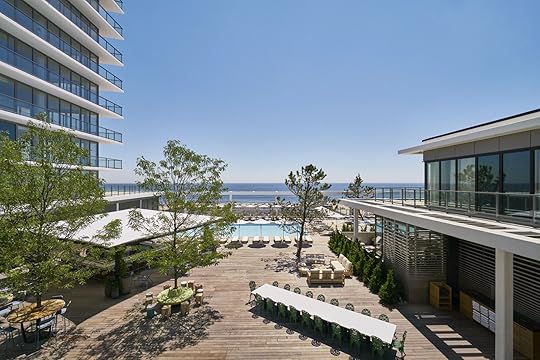
The moment I stepped out of the elevator into the Asbury Park Ocean Club and walked out onto the pool deck, I was transported to an island oasis. At 11:00 AM, when I arrived at the hotel with my partner and nine month old daughter, the pool was still subdued (though it would get only slightly more crowded later) and staff wandered amongst the lounge chairs waiting to take orders. We settled into an empty sofa under an umbrella and ordered drinks, absorbing the relaxed atmosphere as our daughter peacefully played between us on the cushions. It was exactly what we needed to transition into vacation mode.

Pool. Photo: Asbury Ocean Club Hotel/Nikolas Koenig
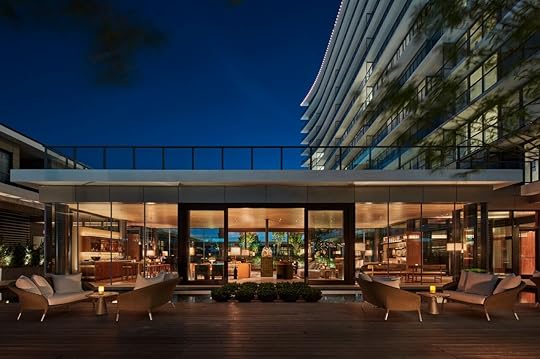
Pool deck at night. Photo: Asbury Ocean Club Hotel/Nikolas Koenig
The Asbury Park Ocean Club is a chic upscale hotel steps from the boardwalk in Asbury Park, and while it offers views of the beach and the pedestrians below, it’s removed from the typical noise and chaos of the Shore. You can watch the energy of the boardwalk unfold from a safe distance, a refreshing dose of tranquility in an environment that tends toward pandemonium.
One of the most iconic towns on the Jersey Shore, Asbury Park, is best known for its music — the Stone Pony is a legendary music venue where Bruce Springsteen and Bon Jovi have played shows — and restaurant scenes. Spots like R BAR, which pays tribute to New Orleans cuisine and cocktails; Wonder Burger, another music and site of Yappy Hour, when dogs are welcome guests; and Asbury Park Oyster Bar, all make this Jersey Shore town a youthful, fashionable destination. Even the boardwalk, where you’ll find just one low-key arcade and a spot for Korean tacos, and another for lobster rolls, feels more refined than most places on the shore.
The Asbury Park Ocean Club, which falls squarely into the boutique hotel category, fits right in with this scene. The first thing you’ll probably notice is the decor. Chic and minimalist, the design defines sophistication.

The Gallery. Photo: Elisabeth Sherman
You’ll find a calming sage green color scheme in the dining room — called the Gallery. From here, floor-to-ceiling windows look out onto the pool deck, so diners get a view of the outdoors, too. This small space, where tiny potted succulents adorn marbled tables, is where guests can enjoy breakfast, lunch, or dinner in tranquility — there are around six tables that seat two people each. I took advantage of this by enjoying a couple glasses of champagne while my daughter took a nap — it was the most peace I had had in months. The burger is also exceptional, perfect lunch fare after spending the afternoon out in the sun.
Guests can indulge in a first-class meal, from a menu by chef Kate Gagliardi. If you’re looking for an upscale restaurant experience, opt for the seven-course tasting menu, which offers dishes like a fresh, summery tomato salad, whipped bone marrow, and charred leeks.

Breakfast sandwich and the whipped bone marrow from Chef Kate’s tasting menu. Photo: Elisabeth Sherman.
In the adjoining Drawing Room, the deep, rosy-orange and emerald green velvet chairs have rounded backs, and simple light fixtures above sofas stacked with plush cream-colored pillows, complete a space that can be a refuge or gathering space for a more upbeat experience. When the DJ shows up, the Drawing Room pulses with music — a perfect vibe for groups of guests who want to enjoy a few drinks before going for a swim. But when the DJ isn’t working, the Drawing Room is a comfortable lounge that you could spend all day relaxing in.

The Drawing Room. Photo: Elisabeth Sherman

Drawing Room. Photo: Asbury Ocean Club Hotel/Nikolas Koenig
It might surprise you to learn that although the Asbury Park Ocean Club has a decidedly upscale atmosphere, where everything around you feels perfectly appointed and in a carefully considered place, it’s exceptionally accommodating to kids.
When my family stayed there, there were kids happily splashing in the pool, kids reading quietly in the Drawing Room, and even a couple of kids running around the dining room. There was never a hint that these children were causing an inconvenience or were unwelcome or a nuisance. In such an elegant hotel, that attitude felt like such a relief — we didn’t have to worry that wandering around the hotel with our daughter — who at nine months is still prone to meltdowns and outbursts — would be an imposition on the staff or disturb the other guests.
I would recommend the Asbury Park Ocean Club for how accommodating it is to parents alone — other families will empathize that any environment that welcomes kids rather than scowling judgmentally (metaphorically at least) the moment they make a sound is welcome. But there are some issues with the hotel that are hard to overlook.

Suite. Photo: Asbury Ocean Club Hotel
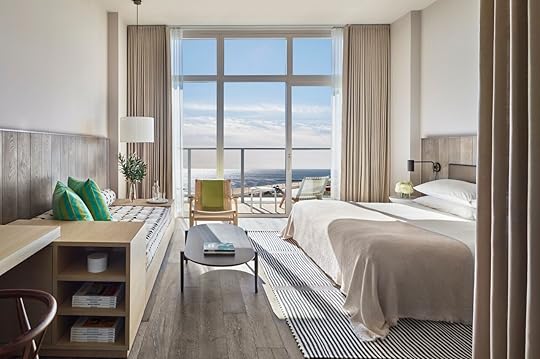
Suite. Photo: Asbury Ocean Club Hotel
A suite with an ocean view will run guests upwards of $700 per night, so guests — whether they are accustomed to that level of luxury or saved up for a family vacation — should expect VIP treatment. Yet, it felt as though the attentiveness of the staff wasn’t evenly distributed.
Here’s what I mean: When we arrived at the hotel they warned us that our room wouldn’t be ready — totally fair, we got there well before check in and wanted to lounge by the pool with a drink before we got settled anyway.
After an hour went by, I flagged down a passing staff member and asked if he could check on the status of the room. My daughter was happily playing, but it was getting hotter and we wanted to move her inside soon. The staff member told us he would check and then we watched as he walked over to a couple of women sitting near us and launched into a lengthy conversation with them about restaurants. We eventually had to flag down someone else because he had clearly blown us off. I passed by him in the hallway later. He asked if we ever got our room. When I replied we had, he kept walking by without answering or even looking my way.
There is a slight air of chaos to the hotel. Although staff are plentiful, wandering around each room of the hotel eager to take orders or to check on the comfort of the guests, you should be prepared to wait a while for whatever it is you ordered. It felt like they were still getting used to the layout and operations of the place, although it opened in 2016.
I’m not so entitled that I need my alcoholic beverage lickity split, but when it came time to order breakfast, I did find the slow service a bit unnerving. As we were waiting, I knew we were inching closer and closer to a random meltdown from my daughter. But I would be remiss if I didn’t mention the whole staff is exceptionally friendly, and helpful. They gushed over my baby (she is extremely cute, to be fair) and it seemed genuine, and clearly, they wanted to show us a good time.
And we did a good time. Although there’s only one floor of the hotel, which includes the bar, The Gallery, and the Drawing Room, along with the hotel rooms (the upper levels of the property are dedicated to residences), you really could spend your whole weekend lounging around, going for a swim, sipping on cocktails, and then retiring to your room to drink a cup of tea or coffee on your terrace before putting your kids to sleep, then maybe ordering a bit of room service before heading to bed yourself. There isn’t much to do at the Asbury Park Ocean Club besides drink and relax, but honestly, that’s kind of the appeal. You’re on vacation. You don’t need to do anything.
If you do want to get out and explore, though, the beach and boardwalk are just a quick three-minute walk from the hotel’s front door. But I’m betting you’ll find yourself wanting to hurry back. 
June 16, 2022
Disney Just Announced a $110,000-Per-Person, 24-Day Tour To Its Properties Around the World

There are plenty of people across the globe who are obsessed with Disney, and I would consider myself pretty close. I don’t go as far as collecting ears or joining Disney Facebook groups, but when I went to college about 20 minutes from the park, you could find me using my pass every Friday and sometimes multiple times a week. Disney’s latest Adventures by Disney package is for the ultimate Disney fan, but it’s going to cost you — and I mean really cost you.
Disney Parks Around The World – A Private Jet Adventure is a 24-day trip covering six countries and all 12 Disney theme parks, plus wonders like the Taj Mahal, the Pyramids of Giza, and the Eiffel Tower. Guest will be trotted around in a VIP-configured private Boeing 757 operated by Icelandair. Guests will also have access to Disney experts and staff, a personal chef and a physician to get the inside scoop and fun facts about Disney. Accommodations are top tier, with stays at Disney’s Grand Californian Hotel & Spa, the Summit Skywalker Ranch, Tokyo Disneyland Hotel, Disney’s Hotel New York – The Art of Marvel, Disney’s Grand Floridian Resort & Spa, the Shanghai Disneyland Hotel, and more.
While this might sound like the itinerary of your dreams, the cost is pretty appalling. Get ready to shell out $109,995, not to mention if you want to claim your spot at that price point, you’ll need to book for at least two people (yes, that is the price for one person). Otherwise, you’ll have to tack on a $10,995 single occupant fee. While entry to 31 sites, 68 meals, a private jet, and VIP accommodations might be worth that much in theory, I can think of a million other things I’d be willing to spend $110,000 on. There are only 75 spots available, and if the high cost of some of Disney’s other experiences are any indication, they will probably be filled regardless of the price. Tickets will be available in stages, with previous Adventures by Disney guests getting first dibs before it opens up to Golden Oak Members, and then the general public. The trip starts on July 9, 2023, and ends on August 1, 2023.
So if you’re a Disney fan with $110,000-plus burning a hole in your pocket, I guess you know where to put all that cash. 
We Put the ‘Shark Tank’-Famous Beach Chair To the Test and Found Our New Favorite Summer Seat

“Shark Tank” is one of my guilty pleasures and has been since high school. There’s something about extremely wealthy people fighting over products that could make them more wealthy that fascinates me. And there was one product during Season 13 that definitely made me curious: The SUNFLOW beach chair. SUNFLOW promised a change to beach gear for the first time in years. And especially since the company claimed to have made $2.9 million in sales in a little over its first year and has a 96 percent satisfaction rating on its website, it must be doing something right.
The SUNFLOW chair has a couple of unique features. While lugging around your other beach gear like towels, sandcastle gear, and a cooler, SUNFLOW is easy to add on because it can be carried like a backpack. There are other beach chairs you can have on your back, but SUNFLOW does it with just a touch of a button (and folds back up easy, too). It can be a little intimidating the first time you do it, but once you understand how it works, it’s pretty easy to do and you could teach your kids to open their own. It’s also made with rust-free aluminum and soft fabric that’s difficult to submerge in water. That means if the tide suddenly gets high, your chair doesn’t suffer.
View this post on InstagramA post shared by SUNFLOW (@getsunflow)
The SUNFLOW chair sits about nine inches off the ground. I found that a little low for my liking, but on “Shark Tank” the owners, Greg Besner and Leslie Hsu, mention that a chair that gets a little higher is in the works. One positive about being low to the ground? All the easier to feel the sand between your toes. I also liked that I was at the same level as my friend, who was lying on a towel beside me.
SUNFLOW’s beach bundle, which I tested out, has perks beyond the chair itself. If you buy the bundle, you get four other products designed to make your chair even more functional. There’s a sun shade that attaches to the top of your chair with a rating of UPF50+ and protects you from 98 percent of the sun’s rays — convenient for anyone concerned about sun damage to their skin. There’s also a drink holder attachment, so no more sand stuck to the bottom of your can or bottle after taking it out of the cooler.
Perhaps my favorite feature is the drybag attachment. I love to spend time in the water, but I’m always concerned about leaving valuables like my phone and keys that I wouldn’t want to get wet. I always think there is a secret agreement between all beach-goers that you don’t touch each others’ stuff. Otherwise, someone has to stand guard. It doesn’t lock, but placing my belongings in the dry bag gave me some comfort, of having my stuff out of sight and (hopefully) out of mind of anyone who would be interested in it.
View this post on InstagramA post shared by SUNFLOW (@getsunflow)
And finally, the towel. It connects to the loops on the back of the chair so you can ensure it stays put and doesn’t bunch up when you sit. The towel is soft and lightweight, and I can tell there was some thought about making sure it wasn’t like your standard, last-minute-purchase beach towel.
Overall, the chair is functional and comfortable. But the one thing that’s difficult to overlook is the price tag. Compared to a backpack beach chair that runs between $30 and $45, the chair alone will set you back $198, and if you go for the beach bundle (which makes it all the more functional and enjoyable), the price jumps to $296, although you can buy the attachments you want individually as well. It’s hard to overlook that that’s a one-way ticket for me from California to Miami, where I could lay on a beach towel instead. And especially if you want to buy a SUNFLOW for the whole family, just know it’s a luxury item.
I think Kevin O’ Leary made the right choice when he decided to invest. If it’s within your budget, purchasing a SUNFLOW chair will make your beach day enjoyable without much hassle. 
Airbnb Just Made Windmills a Category, and These 9 Have Us Planning a Trip

For those who have always dreamt of nestling into a perch at the top of a windmill, overlooking the sights of these nine cities has finally become a reality on Airbnb. From a creekside mill in Capitola, California, to an oceanside escape on an island in Greece, to a vineyard villa mill in the french countryside — these windmill Airbnbs make for an unforgettable stop to spend the night or enjoy a holiday in a special way.
We hope you love the windmill Airbnbs we recommend! Just so you know, Matador may collect a small commission from the links on this page if you decide to book a stay. Listed prices are accurate as of the time of publication.
This Luxurious, Historic Windmill and Silo House Combo in Capitola, California
Photo: Airbnb

Photo: Airbnb

Photo: Airbnb

Photo: Airbnb

Photo: Airbnb
At this windmill silo house in the laid-back West Coast surfer town,12 guests can fit in the six bedrooms on property located in two separate tower home buildings. The two buildings share a common yard space, complete with a patio, putting green, hot tub, and large porch with a built-in barbecue and fire pit for cozy evenings under the stars. Everything in this whimsical spot was custom made and is popping with bright colors from every direction. From the windmill kitchen’s tangerine orange cement countertops to the colorful textured backsplash made from recycled San Francisco bus stop glass in the silo kitchen — it’s a fun and playful place to stay for guests of any age. And the location is prime — the property sits on a tranquil path along the Soquel Creek which is just steps from the beach and Capitola Village.
Twelve guests, six bedrooms
Price: $1,495 per night
Dig these windmill Airbnbs? Check out Matador’s guide to the most unique stays worldwide:10 epic treehouses you can actually rent on AirbnbThese Airbnbs make you feel like you’re living in Game of ThronesStay like royalty at these Airbnb Ireland castle rentalsThis Historic Mill in Ponta Delgada, S. Miguel in the Azores of Portugal

Photo: Airbnb

Photo: Airbnb

Photo: Airbnb

Photo: Airbnb
This historic Mill on the Azores in Portugal dates back to the 19th century and features sweeping 360 degrees views of the ocean and surrounding countryside from the top floor. Guests can spread out in the full bedroom with a king-size bed, and a thoughtfully decorated living space that includes a kitchenette. Outside, visitors can explore the enormous garden, which grows a multitude and flowers and flowers each season. But perhaps the best part of this special spot is the easy access to the sand — it’s a beachfront property, with sights of the ocean from nearly every angle, making for unforgettable sunrise and sunset opportunities.
Two guests, one bedroom
Price: $150 per night

Photo: Airbnb

Photo: Airbnb

Photo: Airbnb

Photo: Airbnb
This Wooden Windmill in Murcia, Spain is surrounded by lemon trees and overlooks the Murcia orchard, featuring a large outdoor patio upstairs for spending time in the sunshine. It’s just a ten-minute drive from downtown but feels like a secluded oasis for rest and relaxation. There’s a full bathroom on the ground floor — and on the second floor, guests will find a bedroom with a double bed, a mini kitchen with a coffee maker, an induction plate for cooking, and a refrigerator. The second floor features a bedroom with a queen-sized bed and a terrace overlooking the lemon groves of the Murcia orchard as an ideal spot to soak up some Spanish sunshine.
Four guests, two bedrooms
Price: $57 per night

Photo: Airbnb

Photo: Airbnb

Photo: Airbnb

Photo: Airbnb
This charming stone mill in the countryside of France is a perfect hideaway for two people to relish in a quiet escape in the heart of the Margaux vineyards. Enjoy a panoramic view of local vineyards and castles out the large windows after climbing a whimsical spiral staircase to the upstairs area. The bathroom even features a traditional clawfoot tub for the ultimate in bathtime relaxation. Outside, there’s a swimming pool and a terrace equipped with a barbecue, a hammock for reading or snoozing, and a romantic garden filled with blooming flowers. Guests can even request bicycles while visiting, to explore the local vineyards and surrounding region.
Two guests, one bedroom
Price: $140 per night

Photo: Airbnb

Photo: Airbnb

Photo: Airbnb

Photo: Airbnb
This Tuscan escape only accepts weekly reservations from Saturday to Saturday — but it’s worth every extra moment spent on-site. This mill is remote and tucked away from other local businesses and houses so that guests will have their own space to enjoy (especially the breathtaking sunsets and stargazing opportunities!). The structure itself is a well-preserved mill from the 1600s and still has most of its original parts. It’s equipped with modern-day comforts including satellite TV, a dishwasher, WiFi, and even a swimming pool. But the best part of a visit to this spot is the panoramic sights spanning across the rolling hills of the Tuscan countryside. Visitors can take a calming walk in the woods and rediscover a sense of tranquility outside of city life.
Five guests, two bedrooms
Price: $146 per night

Photo: Airbnb

Photo: Airbnb

Photo: Airbnb

Photo: Airbnb
This large, family-run Potamitis Windmill and apartment building consist of two separate windmills with two double rooms and an apartment — and each of these options features its own gorgeous seaside views off the coast of Greece. The property sits on a spectacular spot in Korithi, which is a small settlement in northwestern Zakynthos Island. Here, travelers can check out a range of restaurants, taverns, and shops, as well as scenic sights like the local lighthouse, the Blue Caves and Shipwreck cove, and a range of beautiful beaches. In addition to a comfy double bed, the White Windmill offers amenities including air-conditioning, a TV, Wi-Fi, and a mini-fridge. An added bonus that separates this from the other windmill Airbnbs is the sizeable outdoor area with a veranda that hosts uncompromised views of the Ionian Sea.
Two guests, one bedroom
Price: $149 per night

Photo: Airbnb

Photo: Airbnb

Photo: Airbnb

Photo: Airbnb
The Llancayo Windmill sleeps 12 guests in six bedrooms and sits roughly two miles north of the former market town of Usk in Monmouthshire. The mill was first been built in 1813 but was destroyed by fire around 1830 — and until a few years ago, it had still stood as a ruin. Today, the building has been recently renovated and stands tall as a luxurious vacation retreat. Using the mill as a home base, visitors can easily traverse the quaint and rural town of Usk, which is conveniently located in the center of Monmouthshire and hosts award-winning restaurants, shops, and taverns to explore. On the property, guests can relax in the secluded garden out on the first-floor balcony and savor the fresh countryside air.
Twelve guests, six bedrooms
Price: $955 per night

Photo: Airbnb

Photo: Airbnb
At The Impossible Dream, visitors can sleep in a cozy, artisan-crafted windmill in a quaint village of just 100 people, tucked in the Rosebud River Valley which feels like an oasis away from the chaos of everyday life. The windmill features fantastic sights of the cliffs of Rosebud toward the north, the cattle on the Rosebud hill to the east, and the rooftops of the village out to the west. The 360° wrap-around deck outside of the octagonal-shaped bedroom is the perfect spot to sip on an evening glass of wine or a morning coffee after a quiet night’s rest. Guests will also enjoy amenities including a queen bed, a fireplace, and WiFi with a full kitchen with a wood stove for guests to cook their own meals.
Three guests, one bedroom
Price: $271 per night

Photo: Airbnb

Photo: Airbnb

Photo: Airbnb

Photo: Airbnb
In this holiday home topped with a historic windmill in Germany, four guests can experience staying in an authentic grain mill that dates back to the 18th century. It has since been lovingly restored and encompasses almost 1,300 square feet (108 square meters) on the ground floor with high ceilings and majestic, exposed beams. The decor is cozy, with farm-style furnishings mixed with pieces of the original mill to create a unique style and interior. There’s also underground heating to keep visitors feeling toasty. Outside, travelers can explore the large, partially fenced-in garden which boasts privacy from being partly obscured by the surrounding shrubbery. 
Four guests, two bedrooms
Price: $85 per night
The 7 Best Places To Stay Near North Cascades National Park

Abutting the US border with Canada, North Cascades National Park is a land of contrasts. Cerulean blue lakes sit at the foot of mountains forested in deep green pines, with their peaks capped in snow and pointing to the heavens. The park mirrors the various landscapes of the Pacific Northwest, shifting from mountainous areas dominated by rain showers and heavy snowfall to arid plateaus cut by glaciers since melted into alpine rivers and lakes. The park is remote, accessible only by the beautiful North Cascades Highway or from hiking trails to the north.
If hearing about the park’s 400 miles of hiking trails doesn’t leave you immediately plotting an escape to north-central Washington, then your pulse beats to a different drum than does mine. But if you’re on the same wavelength, you’ll be stoked to know that while the park offers ample camping, there are also many comfortable lodges nearby perfect for relaxing after a day of adventure.
Prices will be highest from June through September, after the snow melts and the trails are in prime condition. Autumn can be a great time to visit to avoid the summer crowds, though even when busy, the park remains under-trafficked. While the adjacent (and semi-affiliated) Ross Lake National Recreation Area draws over 900,000 annual visitors, the park itself only drew 38,000 in 2019. You could visit on a balmy Saturday in July and once you get two miles of trail behind you, not see another person all day.
These are the top options for North Cascades National Park lodging.
We hope you love the North Cascades National Park lodging we recommend! Just so you know, Matador may collect a small commission from the links on this page if you decide to book a stay. Listed prices are accurate as of the time of publication.
Flying into Seattle? Check out Matador’s guides to the best Seattle Airbnbs and Seattle airport hotels.
Accommodations for hardy hikersNorth Cascades Lodge at Stehekin
Photo: North Cascades Lodge

Photo: North Cascades Lodge

Photo: North Cascades Lodge
Near the northern tip of Lake Chelan is North Cascades Lodge at Stehekin. This rustic lodge is accessible only via boat, trail, or — if you want to make a grand entrance — sea plane. Be warned that it’s a 23-mile hike to get close, and then you’ll have to take a bus from the terminus — this lodge is seriously remote. Accommodations range from private cabins to bed-and-breakfast-style rooms, one of which has a kitchen. Of all the North Cascades National Park lodging, this property is the best for true adventurers.
Price: From $146 per night
Hotels in Winthrop, WashingtonIn comparison to most of the tiny towns and settlements near North Cascades National Park, Winthrop (population 340) is a veritable metropolis — at least in terms of accommodations. The town has several hotels and lodges about an hour from the park.
River’s Edge Resort
Photo: Booking.com

Photo: Booking.com

Photo: Booking.com

Photo: Booking.com
River’s Edge Resort offers all the basic amenities your group or family needs when exploring a national park. All rooms have hot tubs, private balconies, and kitchenettes, and some chalets even have full kitchens. Choose from one-, two, or three-bedroom cabins, with or without river views. The lodge is great for family gatherings, and the dining options in Winthrop are pretty much all nearby, with a maximum five-minute walk.
Price: From $210 per night
Sun Mountain Lodge
Photo: Booking.com

Photo: Booking.com

Photo: Booking.com

Photo: Booking.com
Sun Mountain Lodge is the perfect North Cascades National Park lodging option if you’re traveling with kids. The pool is large, the views are fantastic, and the adults can lounge poolside or in a jacuzzi tub with epic views of the mountains. The hotel has a restaurant and bar, along with a great fireside lounge. If you plan to spend time in the area to horseback ride or get on the water in addition to visiting the park or cruising the North Cascades Highway, this is the place to base yourself.
Price: From $218 per night
AbbyCreek Inn
Photo: Booking.com

Photo: Booking.com

Photo: Booking.com

Photo: Booking.com
AbbyCreek Inn is just outside Winthrop. The property has a nice pool and hot tub, and a large courtyard perfect for cornhole and other games, as well as BBQs. The hotel also offers free bike rentals for pedaling along the waterfront or heading into town to grab dinner. Rooms are clean and cozy, set up motel-style overlooking the large courtyard and pool area. Breakfast is served each morning in the lobby.
Price: From $93 per night
Hotels in Concrete, Rockport, and MarblemountMt. Baker Hotel
Photo: Booking.com

Photo: Booking.com

Photo: Booking.com
Mt. Baker Hotel showcases alpine hospitality in a manner only the Pacific Northwest can provide. Mt. Baker itself towers in the background and guests stay in rustic suites on the main strip of Concrete, Washington. The west entrance of North Cascades National Park is 30 minutes up the North Cascades Highway.
Price: From $75 per night
Glacier Peak Resort and Winery
Photo: Glacier Peak Resort & Winery

Photo: Glacier Peak Resort & Winery

Photo: Glacier Peak Resort & Winery
Who doesn’t love a glass of local wine after a good hike? Glacier Peak Resort and Winery is located along the North Cascades Highway between Rockport and Marblemount. Guests can stay in a private cabin or book a private tent camping spot or RV spot. And the lodge has a laundromat for your sweaty hiking clothes. The lodge, restaurant, and wine tasting room are just 15 minutes from the park’s west entrance, making it easy to go right from hiking to happy hour with minimal delay.
Price: Cabins from $129 per night, campsites $25 per night
Where to stay near the town of GlacierNorth of Mt. Baker, the town of Glacier provides quick access to many trailheads leading into North Cascades National Park’s northwest side, near Mt. Baker Ski Area. If you plan to trek the Copper Ridge Loop or any of the surrounding trails, basing yourself in the area for a night beforehand is a good way to relax and prepare before starting your trek the next day. There are a handful of great Airbnb rentals in the area to serve as your North Cascades National Park lodging.
Mt. Baker cabin with hot tub and forest views
Photo: Airbnb

Photo: Airbnb

Photo: Airbnb

Photo: Airbnb
This stilt-elevated cabin in Mt. Baker National Forest is just outside Glacier. The cabin features an outdoor cedar hot tub and memory foam mattress inside, so you’ll be comfortable no matter where you hang out. There’s a propane fireplace to keep warm and a kitchen so. you can whip up a packed lunch before hitting the trails. Because this cabin is so close to the town, you have access to the amenities of the Snowline neighborhood including a fish pond, a recreation center, an outdoor pool, and a playground. It’s definitely one of the more elegant North Cascades National Park lodging options, if you can swing the bill.
Four guests, one bedroom
Price: $450 per night

Photo: Airbnb

Photo: Airbnb

Photo: Airbnb

Photo: Airbnb
There’s something about the calming flow of river water that helps you relax and focus before heading out on an outdoor adventure. Located along the Nooksack River just off the Mt. Baker Highway, this apartment provides a great place to lay out your gear and get it organized before heading into the park. There’s a full kitchen, a fireplace, and a bedroom. 
Four guests, one bedroom
Price: $96 per night
Find Your New Favorite Food-Centric Summer Getaway on This Canadian Archipelago

Located in the Gulf of Saint-Lawrence, a five hour ferry ride from Prince Edward Island, is Îles de la Madeleine (sometimes also known as The Magdalen Islands in English). This pristine Québec archipelago is a welcome escape from the mainland; with its red sandstone cliffs, rolling green hills, sandy beaches, and cool salty waters. You won’t see fences here, unless there is livestock in need of boundaries, just wide open spaces, and brightly coloured houses.
Îles de la Madeleine (Munagesunok in Mi’kmaw) is part of the traditional lands of the Mi’kma’ki people of the Mi’kmaw Nation, whose lands also include parts of Canada’s Atlantic Provinces, Québec’s Gaspé Peninsula, and Maine. In the summer months, the Mi’kma’ki people likely fished and hunted around the archipelago, which had an abundance of seals, walruses, herring, and cod.
Prior to the arrival of Jacques Cartier on Île Brion in 1534, Basque fishermen frequented the waters of the archipelago. Some 200 years later, several Acadian families were forced to move to the archipelago by the English, and the first real settlement here was established around 1755. At the time, the waters were higher, and the islands were not connected. In fact, the islands remained unconnected until the early-20th-century.

View from Cap Alright in Havre-aux-Maisons and the lobster risotto at Quai 360. Photo: Pamela MacNaughtan
There are eight islands in the archipelago, six of which – Grande Entrée, Grosse Île, Pointe aux Loups, Havre aux Maisons, Cap-aux-Meules, and Havre-Aubert – are connected by sandbars and a small highway, QC-199. The remaining two are Île d’Entrée, which can be reached by ferry from Cap-aux-Meules, and uninhabited Île Brion.
You’ll find that each island has its own vibe, and in some cases, their own accent as well. While the archipelago is predominantly French-speaking, there are two English-speaking islands, Grosse-Île and Île d’Entrée. The island’s population of 12,010 is Acadian, French, and English. This blend of cultures has birthed a unique local dialect, which is heavily laced with marine vocabulary.
Fishing is a major part of life here, and almost every family on the islands has fishermen in their ranks. The waters surrounding the archipelago are rich with herring, cod, scallops, muscles, and lobsters. Most of which is sold to countries such as Japan and the United States. Lobsters are sweet and a little salty thanks, in part, to the rocky bottom of the Saint-Lawrence river.
There was a time on the archipelago when having a lobster sandwich in your school lunch was a mark of shame. It meant your father was a fisherman, and that your family likely could not afford peanut butter and jam, as food from the mainland arrives by ferry and can be quite expensive. Today, there is increased pride surrounding the foods caught, cultivated, and created on Îles de la Madeleine. Local chefs and the younger generations are working to keep Madelinot traditions alive, while also innovating, creating an exciting array of culinary experiences. Here is where to go and what to eat on Îles de la Madeleine.
Where to eat in Cap-aux-Meules
L’Arbre à Pains. Photo: Pamela MacNaughtan
Cap-aux-Meules is the commercial heart of Îles de la Madeleine. This is where the ferry docks, and you’ll find a handful of restaurants and bars here. As well as shops selling artisan handicrafts.
Quai 360: Located near the ferry port in Cap-aux-Meules, this small unpretentious restaurant is one of the best on the archipelago. They are known for their market cuisine, especially dishes made with lamb or lobster. The island lamb ribs with spiced honey are highly recommended when available.
Where: 360, chemin du Quai, Cap-aux-Meules
L’Arbre à Pains: A few doors down from Quai 360 you’ll spot L’Arbre à Pains, a small pâtisserie in a yellow house. Stop by to try their macaroons, cupcakes, scones, and little pastries. The croissants are the best on the archipelago. Many are made with local ingredients such as beets, zucchini, carrots, dune peppers, and lavender.
Where: 317-1 chemin du Qaui, Cap-aux-Meules
Chez Renard: A small bistro in a bright green house, head to Chez Renard for an excellent lunch or dinner. The menu is small and seasonal. The café counter features baked goods from L’Arbre à Pains, which is down the street.
Where: 315 chemin du Quai, Cap-aux-Meules
Les Pas Perdu: There are two Les Pas Perdu, one is a bar with live musical performances (green house), the other is a restaurant (orange house), and they are a 2 minute drive apart. The restaurant serves beer from À l’Abri de la Tempête, in l’Étang-du-Nord, and their poutine includes cheese from Pied-de-Vent, on Havre-aux-Maisons. You will also see a loup-marin burger, which is made from seal.
The use of seal meat and oil is common in traditional Madelinot cuisine. The seal (loup-marin) population on the archipelago is quite large, and in winter you can visit the Îles de la Madeleine and participate in seal watching activities. Due to the size of the population, a small number are culled each year. Nothing goes to waste, however, and every part of the seal that can be used, is.
Where: 169 chemin Principal
Where to eat in l’Étang-du-Nord
Au P’tit Capitaine. Photo: Pamela MacNaughtan
Located on the island of Cap-aux-Meules, l’Étang-du-Nord is home of one of the largest wooden churches in North America, La Vernière. The fishing harbor is a go-to spot for watching the sunset, strolling down the nearby beach, or dining at one of the restaurants closeby.
Au P’tit Capitaine: One of the best cass-croûte on the archipelago, this small red house is always busy. At Au P’tit Capitaine, you’ll find a menu full of poutine, burgers, smoked meat, and lobster rolls. Sometimes, they’ll have fried chicken. Honestly, everything is good here, making it a can’t-miss experience.
Where: 1244 chemin de la Vernière, l’Étang-du-Nord
Gourmand de Nature: Johanne is a self-taught chef who is known for her salivating menus. Gourmande de Nature is a destination for folks who plan trips around where to eat. The shop is filled with local artisanal products (many made in-house), and ceramics. The bistro menu features local cuisine. Pop by for a tasty light lunch, or make a dinner reservation and immerse yourself in dishes made with local delicacies such as salt cod and seal. Johanne also teaches cooking classes, in French.
Where: 1912 chemin de l’Étang-du-Nord, l’Étang-du-Nord

Lobster roll at LA Cantine. Photo: Pamela MacNaughtan
LA Cantine: Located near Parc de Gros Cap, LA cantine can be found at the LA renaissance cannery. Inside you can purchase live lobsters, as well as lobster meat that has been cooked and immediately frozen. The highlight here, however, is the lobster rolls, which can be ordered with or without fries.
Where: 521 chemin du Gros Cap, l’Étang-du-Nord
À l’abri de la Tempête: This is the archipelago’s microbrewery, and it’s a can’t-miss if you are a craft beer lover. The brewery is located next to the Corfu Island beach, making it an ideal spot for watching the sunset. The brewery produces over nine beers here, including a beer called Corps Mort, which is 11 percent alcohol and is made using smoked malt with herring from Fumoir d’Antan, on Havre-aux-Maisons.
Where: 286 chemin Coulombe, l’Étang-du-Nord
Where to eat in Havre-Aubert
Fromagerie Pied de Vent in Havre-aux-Maisons and Cafe de la Grave in Havre-Aubert. Photo: Pamela MacNaughtan
A large island, Havre-Aubert is home to many artists and producers, as well as La Grâve, the first fishing settlement on the archipelago. There are a few restaurants and producers here to check out.
Café La Grave: This restaurant in La Grâve has been a local institution since 1980, however, the building dates back to 1865 when the area was the port of entry for the islands, and the building was a general store. Today, it is a café-restaurant with live music events. On the menu you’ll find traditional foods such as seal, pot-en-pot, and salt cod, as well as other tasty options.
Where: 969 chemin de la Grave, Havre-Aubert
Fromagerie Les Biquettes à l’Air: This small fromagerie is the first to have dairy goats on Îles de la Madeleine. The fromagerie sells a variety of tasty goat cheese (over 25 varieties), as well as yogurt, chocolate spread, and charcuterie made with goat meat. A delightful stop to pick up foods to enjoy on a picnic, or to take home.
Where: 833 chemin du Bass, Bassin
Verger Poméloi: A cidrerie in Bassin, Verger Poméloi is best known for their fortified apple cider, Poméloi, which is 20 percent alcohol, and has an apple inside the bottle. Visit the cidrerie for a tasting, and try their gin as well.
Where: 33 chemin du P’tit Bois Nord, Bassin
Where to eat in Havre-aux-Maisons
Bacon pizza at Pizza d’la Pointe and Pâtisserie Hélène. Photo: Pamela MacNaughtan
Havre-aux-Maisons is best known for its rolling green hills and brightly painted houses. It is also home to glass-blowers, a few food producers, and eateries that are worth checking out.
Pizza d’la Pointe: It is hard to find a better pizza on the archipelago than at Pizza d’la Pointe. This restaurant has been recently renovated, and is a relaxing space with pretty views. The menu has around 16 pizza varieties, including vegetarian options, as well as seafood (yes, there is also one with loup-marin confit).
Where: 86 QC-199, Havre-aux-Maisons
Hélène des Iles: The sister cafe of Pizza d’la Pointe, and located next door, Hélène is a can’t-miss for all things pastry. Stop for the croissants and chocolatines. Honestly, you will probably want to go back the next day for more.
Where: 90 QC-199, Havre-aux-Maisons
Fromagerie du Pied de Vent: Pied-de-Vent means “foot of the wind”, and is also the name of this shop’s signature cheese. The cheesemakers here also produce cheddar, as well as tomme-style cheese. There is an ecomusée (a type of museum based on a local speciality or community) where you can learn about how the cheeses are made.
Where: 149 chemin de la Pointe Basse, Havre-aux-Maisons
Fumoir D’antan: At one time there were around six herring smokehouses on the archipelago; today, however, Fumoir D’antan is the only still in operation. Visit their ecomusée to learn about the history of smokehouses in Îles de la Madeleine, and stop by the boutique to try some smoked herring.
Where: 27 chemin du Quai, Havre-aux-Maisons
Where to eat in Grosse-ÎleGrosse-Île is home to one of two English communities on Îles de la Madeleine. This area, also known as Old Harry, is home to some of the best beaches in the archipelago. It is mostly residential, with a couple of casse-croûte, the name for a restaurant that serves a light meal or snacks.
Cap Dauphin Fish Shack: This is probably the best of the two casse-crôute in Grosse-Île. It is located at the fishing harbor, Cap dauphin Fish Shack was once inside a refrigerator shipping container. Today, it is a pretty house with washed wooden shingles and plenty of patio seating. The lobster rolls here are quite good, as well as the chowder, and poutine.
Where: 49 chemin Shore, Grosse-Île 
Matador Network's Blog
- Matador Network's profile
- 6 followers



